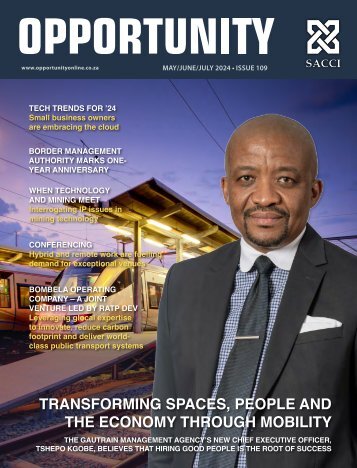South African Business 2016 edition
- Text
- Investment
- Government
- Business
- Development
- Network
- Sectors
- Investing
- Business
- Africa
- African
- Economic
- Manufacturing
- Mining
- Opportunities
- Economy
- Overview
OVERVIEW Phakisa to
OVERVIEW Phakisa to power marine economy The maritime sector holds great promise as, through Operation Phakisa, national government aims to implemement its policies and programmes better, faster and more effectively. Operation Phakisa – in the words of President Jacob Zuma – “has been designed to answer fundamental implementation questions and find solutions, as the country tries to address poverty, inequality and unemployment, among other challenges, as stipulated in the National Development Plan (NDP) 2030. The first phase of the implementation will focus on unlocking the economic potential of South Africa’s oceans.” The simple fact is that South Africa is not gaining as much as it should from the maritime sector. One example is the absence of a merchant fleet and another is the scarcity of ship-repair facilities. With oil and gas finds growing in volume exponentially off the west coast of Africa and off Mozambique, there is a huge opportunity for South Africans to grow big businesses in the rig-repair and service industry. The ocean could contribute up to R177-billion to the Gross Domestic Product (GDP), and add between eight hundred and one million direct jobs. Priority sectors To tap into the ocean economy, government has identified four priority sectors, on which Operation Phakisa will focus. These are marine transport and manufacturing activities, such as coastal shipping, trans-shipment, boat building, repair and refurbishment; offshore oil and gas exploration; aquaculture and marine protection services and ocean governance. Government will explore the country’s natural advantage in maritime transport and manufacturing by capturing the benefits of growing volumes of cargo handling, sea and coastal shipping and supporting transport activities such as storage and warehousing. Operation Phakisa looks at further enhancing the enabling environment for exploration of oil and gas wells, resulting in an increased number of exploration wells drilled, while simultaneously maximising the value captured for South Africa. The need to continuously balance the economic opportunities which the ocean space SOUTH AFRICAN BUSINESS 2016 110
affords, while maintaining its environmental integrity has been recognised, as well as sustainable but commercial practices such as aquaculture. A relatively underdeveloped area and small in size, aquaculture in South Africa has shown strong growth of 6.5 percent per annum, being an increasingly important contribution to food security globally. A coordinated effort Western Cape MEC for Economic Development and Tourism Alan Winde argues that all of the ports of South Africa should cooperate in trying to attract the business of the 130 rigs that pass the country’s ports. The chief executive of the South African Oil and Gas Alliance (SAOGA), Warwick Blyth, told Reuters that South Africa is starting to realise its potential in this market. Cape Town and Saldanha’s facilities were ‘exceptionally busy’, according to Blyth, who noted that each of the three or four repair jobs being done simultaneously was worth about R200-million. DCD Marine operates Cape Town’s rig-repair facility, the largest ship-repair yard in Africa. There are supplementary yards in Simon’s Town and Saldanha. Large logistics operators like Bertling already run sophisticated operations at South Africa’s major ports. JSE-listed Grindrod runs prominent businesses such as Unicorn Shipping and Grindrod Freight Services. Training for the maritime sector is provided by five marine academies in KwaZulu-Natal and the Western Cape. Simon’s Town’s Lawhill Maritime Centre has won awards. Transnet runs a School of Port Operations. SAMSA says there are 341 maritime careers, ranging from marine surveyor to oceanographer. Ports and terminals OVERVIEW South Africa’s port system is controlled by Transnet National Ports Authority. The ports of Richards Bay, Ngqura and East London are in Industrial Development Zones (IDZs). The other commercial ports are Durban, Port Elizabeth, Mossel Bay, Cape Town and Saldanha. The deepest natural port in Southern Africa, the port of Saldahna can accommodate vessels up to a draft of 21.5 metres, exporting most of South Africa’s iron ore. Port Elizabeth has automotive-handling capacity, a container terminal and a break-bulk terminal. The port currently handles large quantities of manganese but this is due to move to Ngqura. The Port of Mossel Bay services the fishing and petroleum industries. Huge amounts of money are being spent on ports and terminals. Container terminals alone will receive R9.8-billion in additional funding in the period to 2019 and all of the country’s ports are receiving upgrades that are increasing their capacity. 111 SOUTH AFRICAN BUSINESS 2016
- Page 1:
SOUTH AFRICAN BUSINESS 2016 EDITION
- Page 6:
CONTENTS Introduction CONTENTS Sout
- Page 10 and 11:
CREDITS Publisher Chris Whales Publ
- Page 12 and 13:
SPECIAL FEATURE South Africa A peri
- Page 14 and 15:
SPECIAL FEATURE In a year that saw
- Page 16 and 17:
SPECIAL FEATURE owes its existence
- Page 18 and 19:
SPECIAL FEATURE against water losse
- Page 20 and 21:
SPECIAL FEATURE Operation Phakisa h
- Page 22 and 23:
SPECIAL FEATURE late in 2014. The h
- Page 24 and 25:
SPECIAL FEATURE Understanding Afric
- Page 26 and 27:
INTERVIEW Job creation on track Ala
- Page 28 and 29:
SPECIAL FEATURE Business funding Th
- Page 30 and 31:
SPECIAL FEATURE in turn makes it ve
- Page 32 and 33:
SPECIAL FEATURE Contact: 012 394 18
- Page 34 and 35:
SPECIAL FEATURE Black Business Supp
- Page 36 and 37:
SPECIAL FEATURE The evolution of sk
- Page 38:
SPECIAL FEATURE providing TVET lear
- Page 42:
PROFILE FP&M Seta Facilitating and
- Page 45 and 46:
• The development of a national s
- Page 48 and 49:
FOCUS Champions of change Five dyna
- Page 50 and 51:
SPECIAL FEATURE The top law firms S
- Page 52 and 53:
SPECIAL FEATURE Keeping the BRICS t
- Page 54 and 55:
SPECIAL FEATURE Keeping BEPS in che
- Page 56 and 57:
SPECIAL FEATURE IPAP in action In 2
- Page 58 and 59:
FOCUS THERE’S NO END TO THE BENEF
- Page 60 and 61:
INTERVIEW The riches of Africa awai
- Page 62 and 63: INTERVIEW and it could actually be
- Page 64 and 65: PROFILE ECIC exco profiles Profiles
- Page 66 and 67: INTERVIEW The hub of Africa Tim Har
- Page 69 and 70: Key sectors Overview of the main ec
- Page 71 and 72: OVERVIEW from the subsistence farme
- Page 73 and 74: OVERVIEW South Africa produces abou
- Page 75 and 76: South Africa’s looming energy gap
- Page 77 and 78: How will these resources be develop
- Page 79 and 80: Vall exclusive economic zone limits
- Page 82 and 83: OVERVIEW NEED PIC Mining The South
- Page 84 and 85: OVERVIEW Mineral beneficiation The
- Page 86 and 87: PROFILE The Council for Geoscience
- Page 88 and 89: OVERVIEW Energy The South African e
- Page 90 and 91: INTERVIEW Cummins South Africa Cumm
- Page 92 and 93: OVERVIEW Manufacturing Increasing m
- Page 94 and 95: OVERVIEW Automotive International i
- Page 96 and 97: OVERVIEW Automotive components Incu
- Page 98 and 99: OVERVIEW Chemicals and pharmaceutic
- Page 100 and 101: OVERVIEW Healthcare South Africa’
- Page 102 and 103: OVERVIEW Water Severe water restric
- Page 104: OVERVIEW Improving quality The intr
- Page 107 and 108: Our Vision is is “Quality water f
- Page 109 and 110: OVERVIEW 107 SOUTH AFRICAN BUSINESS
- Page 111: OVERVIEW airports in India and Braz
- Page 115 and 116: kets, except Australia. In Africa,
- Page 117 and 118: Rosebank, Johannesburg, renamed ‘
- Page 119 and 120: Trade with Africa Improved infrastr
- Page 121 and 122: FOCUS MTN plugs R1.2-billion into K
- Page 123 and 124: MTN rolls out fibre infrastructure
- Page 125 and 126: OVERVIEW community engagement. The
- Page 127 and 128: PROFILE For BEE Verification and is
- Page 129 and 130: OVERVIEW attracting and retaining c
- Page 131 and 132: OVERVIEW Small business is taken ve
- Page 133 and 134: Franchise Fund—an innovative plat
- Page 135 and 136: educating young people in fields th
- Page 137 and 138: OVERVIEW Management Plan has divert
- Page 139 and 140: hazardous waste is also not being c
- Page 141 and 142: INTERVIEW yourself up as a Tier 1 o
- Page 144 and 145: OVERVIEW Renewable energy South Afr
- Page 146 and 147: INTERVIEW Plenty of scope for solar
- Page 148 and 149: LISTINGS South African business org
- Page 150 and 151: LISTINGS South African National Gov
- Page 152 and 153: LISTINGS Department of Communicatio
- Page 154 and 155: LISTINGS Department of Human Settle
- Page 156 and 157: LISTINGS Department of Science and
- Page 158 and 159: OVERVIEW Regional overview: Eastern
- Page 162 and 163:
INTERVIEW Buffalo City on the rise
- Page 164 and 165:
OVERVIEW Regional overview: Free St
- Page 166 and 167:
OVERVIEW Regional overview: Gauteng
- Page 168 and 169:
FOCUS A Catalyst for Economic Devel
- Page 170 and 171:
FOCUS business people and tourists
- Page 172 and 173:
OVERVIEW Regional overview: KwaZulu
- Page 174 and 175:
OVERVIEW Regional overview: Limpopo
- Page 176 and 177:
OVERVIEW Regional overview: Mpumala
- Page 178 and 179:
The powerhouse of Africa Mpumalanga
- Page 180 and 181:
Mpumalanga: Key Sectors Mpumalanga
- Page 182 and 183:
Nkomazi Special Economic Zone The N
- Page 184 and 185:
INVEST IN THE PROVINCE OF THE RISIN
- Page 186 and 187:
OVERVIEW Regional overview: Norther
- Page 188 and 189:
OVERVIEW Regional overview: North W
- Page 190 and 191:
OVERVIEW Regional overview: Western
- Page 192 and 193:
FOCUS Khayelitsha - the power of to
- Page 194 and 195:
INDEX INDEX Abeco Tanks ...........
- Page 196:
ENSafrica.com ENSafrica | Africa’
Inappropriate
Loading...
Mail this publication
Loading...
Embed
Loading...






















































































































































